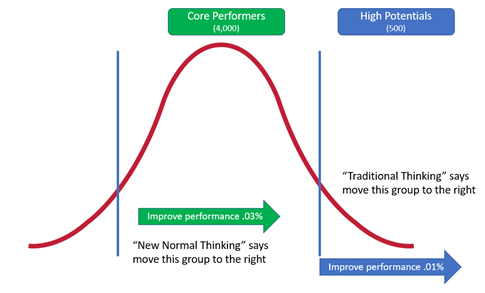As long as I can remember, corporate talent development strategies were designed and forged by natural limiters such as the time, money, and resources required to bring employees in to attend stand-up, face-to-face learning events. As a result, when talent development professionals looked at their organizations, they were faced with the choice of the bell curve: either focus on the “far right side” of the curve, those defined as strong, high potential performers, and let the rest of curve fend for themselves. I recall one client say many years ago that the cost justification analysis of moving the far right a fraction further to the right was far more effective than moving the rest of the curve to the right.
stand-up, face-to-face learning events. As a result, when talent development professionals looked at their organizations, they were faced with the choice of the bell curve: either focus on the “far right side” of the curve, those defined as strong, high potential performers, and let the rest of curve fend for themselves. I recall one client say many years ago that the cost justification analysis of moving the far right a fraction further to the right was far more effective than moving the rest of the curve to the right.
Example
Let’s take a look at a straightforward and realistic scenario:

In this scenario, there are two audiences that can be impacted by a Talent Development initiative: High Potentials and Core Performers. Traditionally, organizations would make the decision to just focus on the high potentials because of the cost. The math goes something like this:
The goal of the high potential program is to increase skills which will lead to better performance. Let’s define better performance as the ability to increase profitability of the firm by .01%. An organization that generates $1 billion of profit would see an incremental impact of $10 million. The cost to design, develop, and deliver a traditional, in-person, residential program would be at least:
- Content, Materials, learning, facilitation: $2,500 per person
- Travel, lodging, meals, etc.: $5,500 per person
If the audience of the high potential group was 500 people, then the total budget would be about $4 million. The Return on Investment (ROI) is the incremental profit of $10 million divided by the total costs of $4 million which is a 2.5 times return.
Now, in the new normal of virtual learning, you can have a population of 4,000 core performers go through a virtual, scalable program to build their skills. Even the slightest bump of increased decision making and business performance for 4,000 people could increase profitability by at least .03%. An organization that generates $1 billion of profit would see an incremental impact of $30 million. The cost to design, develop and deliver a virtual core performer program would be at least:
- Content, Materials, learning, facilitation: $1,000 per person for a world-class, award winning solution
If the audience of the high potential group was 4,000 people, then the total budget would be about $4 million. The Return on Investment (ROI) is the incremental profit of $30 million divided by the total costs of $4 million which is a 6.15 times return.
And here’s the thing: the same organization could also deliver a program to the high potentials at about $1,750 per person and for an additional $875,000 drive the incremental return by another $10 million which would yield over an 8x return on investment faster than ever before.
In summary, virtual learning and the new normal is here to stay because it is better, participants are learning more, they are feeling safer in the learning environment, and there are more dynamic ways to learn like business simulations and virtual role plays. More importantly, as the examples in this blog show, for the first time in the history of corporate talent development, it is possible to accelerate scale and have significant business impact almost immediately at ROIs that previously could not have been imagined.




